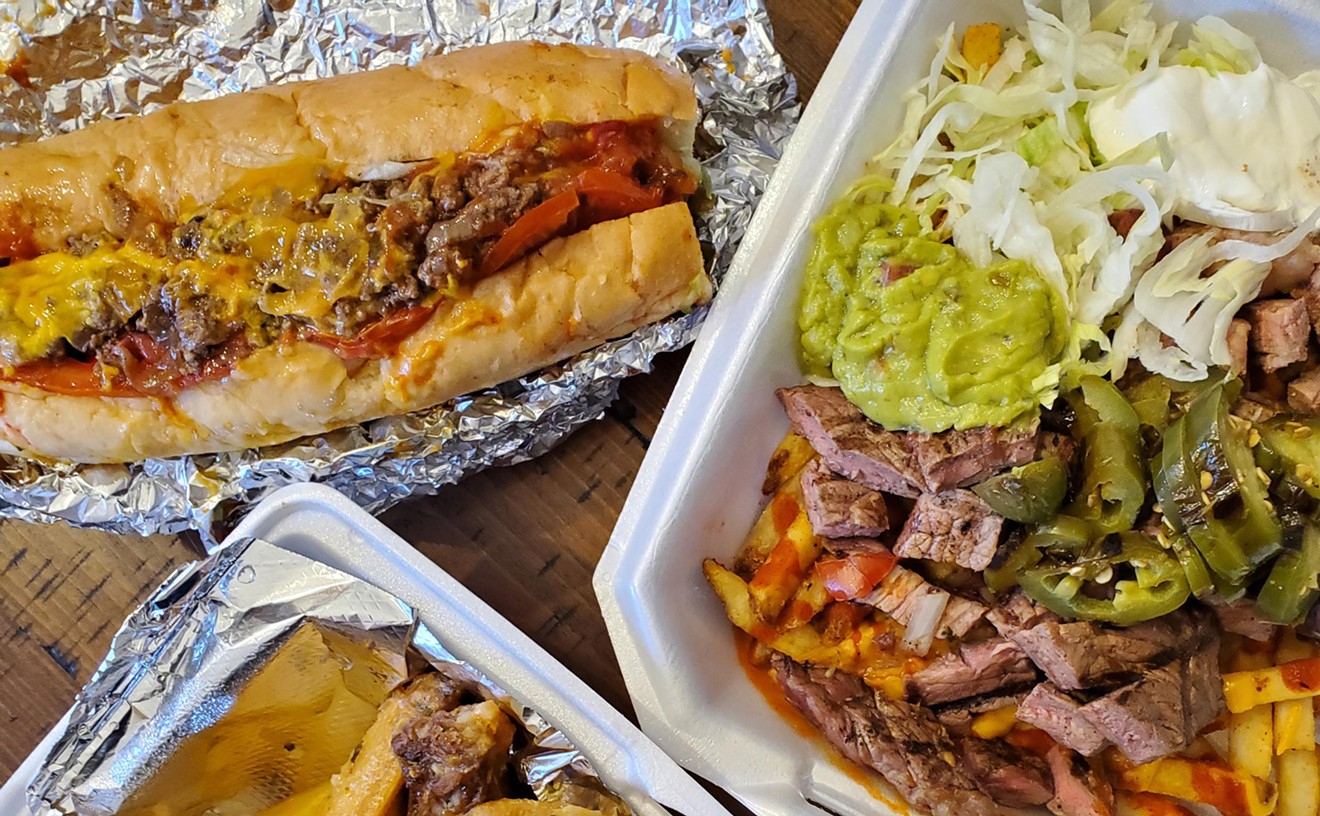See also: Review: Glaze by Sasa Is a Sweet Combination
That big eye tuna, one of several tuna species that show up on Sushi Den's menu, started its life in waters near Hawaii. True World brings in many of these a week; Ramirez breaks down up to twelve a day. While some seafood and sushi restaurants have the resulting cuts delivered to their back doors, Toshi Kizaki drives to True World in Commerce City every morning to select the fish himself. I accompanied the Kizaki brothers on a chilly Tuesday morning to see how Toshi selects the fish and how True World manages to maintain freshness and quality for Sushi Den and other area restaurants.Although I wasn't allowed to take pictures inside True World, there really wasn't much to see. Part of me was expecting the clamorous fish-market atmosphere of big seafood auction sites like the famous Tsukiji market in Tokyo. True World's Denver location is really just a distribution center and warehouse, with a series of walk-in refrigerators and freezers of different sizes and temperatures. Visitors are required to don white coats, rubber gloves and hairnets to help maintain a pristine environment for the seafood.
Yasu Kizaki explains that Sushi Den has built up a relationship with True World over more than fifteen years -- the daily visits aren't standard for the fish company's customers. The Kizakis have a third brother who lives in Fukuoka, Japan, who selects fish from the Nagahama Fish Market and arranges shipment to Denver International Airport, where True World picks it up and brings it to the distribution center twice weekly. There, Toshi loads it into his minivan along with other seafood that True World brings in from U.S. waters and further abroad (so Sushi Den is able to get fresh fish daily from Canada, Europe and even Japan, adding to what is sent from Yasu and Toshi's brother).
"Since we heavily depend on the fishermen as well as the weather," explains Yasu, "the amount of fish that comes into the market fluctuates daily." On our visit, Toshi inspects several big eye tuna and samples the dark reddish-purple flesh. He's looking for signs of bruising that would affect the texture and tasting for fat content. There's a cold room just for tuna with a butchering table where Ismael Ramirez works, clad in multiple layers of clothes beneath his white coat, with heavy waterproof boots to keep out the cold and moisture.
In fact, most of the employees at True World are dressed for the cold; only the office is heated to standard room temperature. "Once you get cold here, you stay cold," says Yasu, handing me some tea so hot the paper cup begins to sag. His brother continues checking fish -- flipping plate-sized halibut and feeling the white bellies; again he's looking for fat content. Yasu explains that winter is the best time of year for fish in the Northern Hemisphere; the waters are colder and the fish put on more fat, which results in more flavor.
In addition to the halibut, taken from waters near Boston, there's uni (sea urchin) packed into small wooden boxes and a haul of razor clams. Toshi looks over the uni and selects several boxes, leaving behind one for reasons that only his experienced eye can detect. True World also distributes specialty produce from the U.S and Japan. Today's load includes Japanese mountain yam, green shiso and daikon radish, but no fresh wasabi root (which is only grown in Japan).
The fish selected, the produce and the shipment from Fukuoka (ten styrofoam boxes) are loaded into the minivan along with a couple of bluefin bellies from a locked chest freezer. Sushi Den is quick to point out that the bluefin on its menu is farmed in Japanese waters (rather than wild-caught), a technique that has only become commercially viable over the past few years in an attempt to reduce the strain of over-fishing from wild tuna populations. Bluefin tuna take years to reach full size and catches have resulted in fewer and fewer giants over the past couple of decades. To give an idea of their size compared to the big eye, one belly (toro to sushi afficionados) weighs in at more than 20 pounds, while the big eye belly from the butchering demonstration was no more than three or four.
Keep reading for more photos of the tuna butchering demonstration and pictures of fish brought back from a morning at True World Foods.
Back at Sushi Den later that morning, the kitchen crew is already prepping for another day of business. It's almost impossible to count the number of employees working, but their are sushi chefs prepping fish, front-of-house staff making last minute preparations in the dining room, dish washers, cooks bent over stock pots and many others transporting food and equipment in the maze of back rooms that connect Sushi Den and Izakaya Den. Some of that crew springs into action as soon as the minivan arrives, unloading the haul and quickly breaking down boxes.The fish from Fukuoka is unpacked from styrofoam boxes; there are layers of reflective mylar, cold-pack envelopes, and plastic bags keeping the fish cold enough that bits of ice still cling to fins and scales, even after a journey from the far side of the globe. Some, like the kinmedai (golden-eye snapper) seem almost alive; their eyes still capture the light of the room and reflect off jet black pupils. Others have been partially broken down to save on shipping expenses -- headless hagatsuo (bonito) and mackerel dwarf smaller whole kohada (shad) and akamutsu (a pretty, snapper-like fish with more than one name in English). A whole ara (saw-edged perch) is also part of the shipment, something Yasu says Sushi Den has only served a few times.
All told, there are almost twenty different species of fish represented that day. Yasu explains that some, like the big eye tuna, actually improve with a little age, while others must be used as soon as possible. In either case, it will all be gone -- served in catch-of-the-day preparations that form a menu separate from the restaurant's standard sushi list.
Follow @CafeWestword











